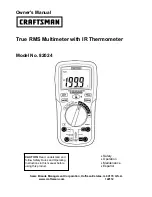
3.6
hFE measurement
4
Setting function switch to hFE position.
5
Determine whether the transistor is NPN or PNP and locate the Emitter. Base and
collector leads. Insert the leads into the proper holes in the socket on the front panel.
6
The display will read the approximate hFE value at the test condition Base Current
10uA, Vce approx. 2.8V.
3.7 Diode and continuity Test
1.
Connect the BLACK test lead to “COM” jack and RED test lead the “V/Ω” jack..
(Note: The polarity of the red test probe is “+”).
2.
Set the FUNCTION switch to “
” position.
3.
Connect the test leads across the diode under measurement, display shows the
approx. forward voltage of this diode.
4.
Connect the test probes to two points of circuit, if the resistance is lower than approx.
70Ω. Buzzer sounds.
Note:
1) When the input is not connected, i.e. at open circuit, the figure "1" will be displayed.
2) There is a milliamp current flow through the diode under test.
3)
The meter displays the forward voltage drop in millivolts and overload when the
diode is reversed.
4. WARNING
1.
When measuring voltage ensure that instrument is not connected or switched to a
current or resistance range, or to the diode check. Always ensure that the correct
terminals are used for the type of measurement to be made.
2.
Use extreme care when measuring voltage above 50V, especially from sources where
high energy is existed.
3.
Avoid making connections to “live” circuits whenever possible.
4.
When making current measurements ensure that the circuit not “live” before opening
it in order to connect the test leads.
5.
Before making resistance measurements or diode test, ensure that the circuit under
test is de-energized.
6.
Always ensure that the correct function and range is selected. If in doubt about the
correct range to use, start with the highest and work downwards.
7.
Extreme care should be taken when using the instrument to conjunction with a
current transformer connected to the terminals if an open circuit occurs.
8.
Ensure that the test leads and probes are good condition with no damage to the
insulation.
9.
Take care not to exceed the over-load limits as given in the specification.
10.
FUSE FOR REPLACEMENT MUST BE OF THE CORRECT TYPE AND
RATING.
11.
Before opening the case of the instrument to replace battery or fuse, disconnect the
test leads from any external circuit, set the POWER switch to “OFF” position.
5. CARE AND MAINTENANCE
5.1Care for your multi-meter
Your Digital Multi-meter is an example of superior design and craftsmanship. The
following suggestions with help you care for the multi-meter so you can enjoy it for year.
1) Keep the multimember dry. If it gets wet, wipe it dry immediately. Liquids can
contain minerals that can corrode electronic circuits.
2) Use and store the multi-meter only in normal temperature environments.
Temperature extremes can shorten the life of electronic devices, damage batteries, and
distort or melt plastic part.
3) Handle the multiyear gently and carefully. Dropping it can damage the circuit boards
and case and can cause the multi-meter to work improperly although the holster can
provide enough protection.
4) Keep the multi-meter away from dust and dirt, which can cause premature wear of
parts.
5) Wipe the multi-meter with a damp cloth occasionally to keep it looking new. Do not
use harsh chemicals, cleaning solvents, or strong detergents to clean the multi-meter.
6) Use only fresh battery of the required size and type. Always remove old or weak
batteries.
They can Leak chemicals that destroy electronic circuits.
5.2 Maintenance
1) 9-Volt battery replacement
a. Ensure the instrument is not connected to any external circuit. Set the selector
switch to OFF position and remove the test leads from terminals.
b. Remove the screw on the bottom case and lift the bottom case.
c. Remove the spent battery and replace it with a battery of the same type.
2) Fuse replacement
a. Ensure the instrument is not connected to any external circuit. Set the selector
switch to OFF position and remove the test leads from terminals.
b. Remove the screw on the bottom case and lift the bottom case.
c. Replace the fuse with same type and rating: 5x20mm, 200mA/250V, fast-blow
fuse or as the replacements.




















